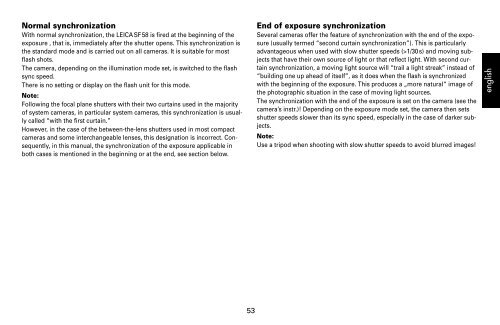You also want an ePaper? Increase the reach of your titles
YUMPU automatically turns print PDFs into web optimized ePapers that Google loves.
Normal synchronization<br />
With normal synchronization, the LEICA <strong>SF</strong> <strong>58</strong> is fired at the beginning of the<br />
exposure , that is, immediately after the shutter opens. This synchronization is<br />
the standard mode and is carried out on all cameras. It is suitable for most<br />
flash shots.<br />
The camera, depending on the illumination mode set, is switched to the flash<br />
sync speed.<br />
There is no setting or display on the flash unit for this mode.<br />
Note:<br />
Following the focal plane shutters with their two curtains used in the majority<br />
of system cameras, in particular system cameras, this synchronization is usually<br />
called “with the first curtain.”<br />
However, in the case of the between-the-lens shutters used in most compact<br />
cameras and some interchangeable lenses, this designation is incorrect. Consequently,<br />
in this manual, the synchronization of the exposure applicable in<br />
both cases is mentioned in the beginning or at the end, see section below.<br />
53<br />
End of exposure synchronization<br />
Several cameras offer the feature of synchronization with the end of the exposure<br />
(usually termed “second curtain synchronization”). This is particularly<br />
advantageous when used with slow shutter speeds (>1/30 s) and moving subjects<br />
that have their own source of light or that reflect light. With second curtain<br />
synchronization, a moving light source will “trail a light streak” instead of<br />
“building one up ahead of itself”, as it does when the flash is synchronized<br />
with the beginning of the exposure. This produces a „more natural“ image of<br />
the photographic situation in the case of moving light sources.<br />
The synchronization with the end of the exposure is set on the camera (see the<br />
camera’s instr.)! Depending on the exposure mode set, the camera then sets<br />
shutter speeds slower than its sync speed, especially in the case of darker subjects.<br />
Note:<br />
Use a tripod when shooting with slow shutter speeds to avoid blurred images!<br />
english


